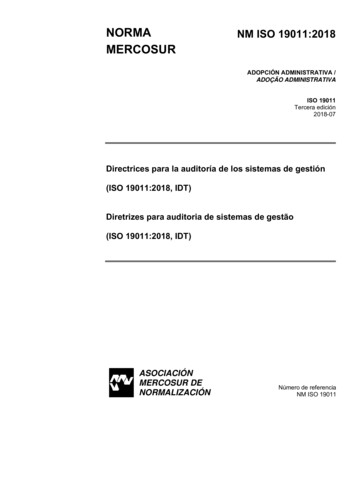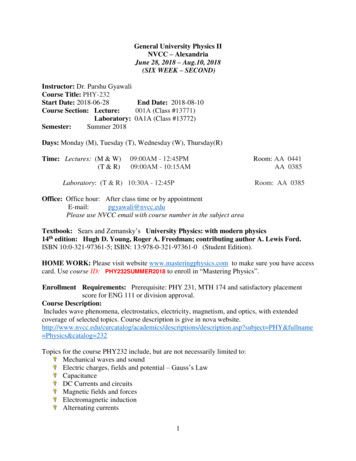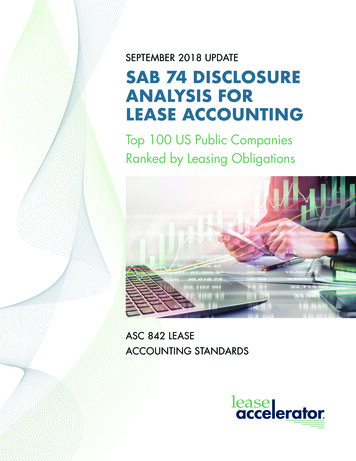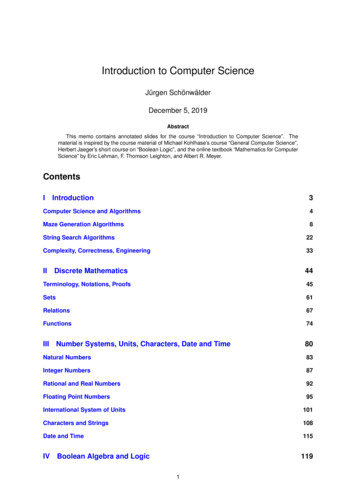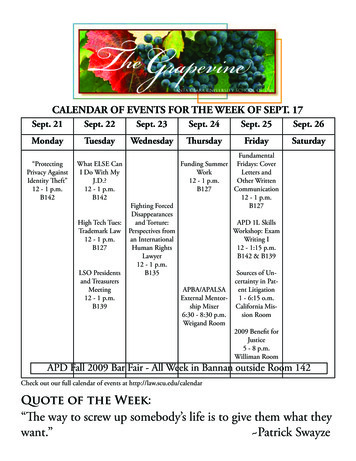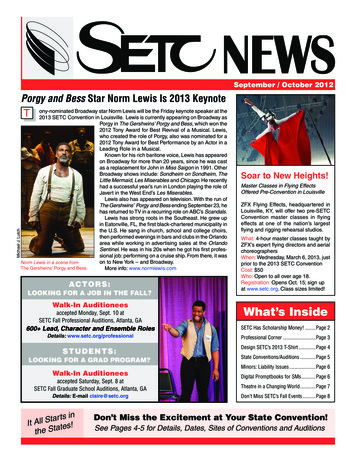
Transcription
Toruń, 26-28 September 2018Long-term care.Is there one path for development?Conference materials
21th International Long-Term Care ConferenceConference Programme26th September 201817:00OPENING CEREMONY27th September 201809:00 - 11:00 SESSION I: INDIVIDUAL NEEDS AND THE STANDARDIZATION OF SERVICES.DILEMMAS IN CONTEMPORARY LONG-TERM CARE.Moderator: Dan Levitt /Canada/Rethinking Aging: Not the Traditional Nursing Home Grandma Lives InDan Levitt /Canada/3Promoting independence using a Positive Risk frameworkJo Croft /England/5The Dignity and Individuality of the Dependent Person. Seni Fosters Care.Leszek Guga /Poland/8Providing for the diverse care needs of dependent older people – solutions beingimplemented in Szczecindr hab. Beata Bugajska /Poland/1111:30 - 13:00 SESSION II: THE IMAGE OF THE LONG-TERM CARE INSTITUTION – HOW TO BUILD ITDELIBERATELY?Moderator: Magdalena Jaworska-Nizioł /Poland/Harnessing the fourth powerMagdalena Jaworska-Nizioł /Poland/13Image of nursing homes, a confusing experience from the most expensive elderlycare system in EuropeJeroen van den Oever /Netherlands/The relational concept of marketing in long-term care.dr hab. Paweł Dobski prof. nadz. UEP /Poland/1
21th International Long-Term Care Conference14:00 - 16:20 SESSION III: WHAT IS THE WORLD UP AGAINST? VARIOUS ASPECTS OF CAREFOR DEPENDENT PERSONS.Moderator: prof. Daniela Soitu /Romania/Japanese Long-Term Care SystemNobumasa Ohmori /Japan/15Can we shape out the aging life? Desires, resources and life lessons.prof. Daniela Soitu /Romania/16Making a Night and Day Difference: Creating a Culture of Restorative SleepHeather Johnson /USA/19The aging population of Ukraine: conclusions and perspectivesdr n. med. Czajkowska Wiera Władimirowna /Ukraine/16:50 - 18:00 SESSION IV: MANAGEMENT IN LONG-TERM CARE IN THE FACE OF STAFF SHORTAGES.Moderator: Grażyna Śmiarowska /Poland/Employee management: „So that the good staff will stay!"Volker Rasche /Germany/A Growing Problem: The Lack of Qualified Nursing Care Personnel asthe Greatest Challenge in Long-Term CareBeata Leszczyńska /Poland/23252
21th International Long-Term Care ConferenceDan LevittRethinking Aging: Not the Traditional Nursing Home Grandma Lives InAcclaimed international speaker, elder care leader, writer, and gerontologist, specializingin helping others to create better lives for seniors. Dan’s purpose is to teach millions ofpeople how to transform the lives of older adults across the globe. As a popularprofessional speaker, he has delivered inspiring keynote speeches impacting thousands ofpeople on four continents. Dan doesn’t tell people where to go but guides them inthe direction of where they need to go. His talks leave the audience with a new mindset onaging needed to thrive in the 21st century.A RethinkOver the next decade, substantial changes are needed to sweep through the eldercare system in response tothe impending rising tide of seniors who will rely on health and social services in unprecedented ways.The need to change is rooted in funding pressures, demographics, technologies, and public expectation forchange–suggesting that transformation to improve the elder care system is both expected and required.A redesign of the delivery of care and housing to the aging demographic will radical shift how programs andservices supporting person-centred care and quality life.Culture ChangeThe need for transforming eldercare from the institutional hospital style nursing home into a centre for livingwhere seniors experience individualized services did not gain momentum until the 1990s when the EdenAlternative was founded by Dr. Bill Thomas, a Harvard-educated geriatrician. The Eden Alternative teaches thatwhere elders live must be habitats for human beings, not sterile medical institutions. Making this typeof fundamental shift in how residential care functions requires leaders to engage actively in systematic inquiryinto the challenges that the status quo supports questioning the assumptions by asking questions such as whois benefiting from the current organizational structure.A Small HouseThe small house model creates private residences where 10-12 people live, and complex care is offered in thathousehold. In this model of living the comforts of home are combined with individualized complex nursingcare. It does not look like a nursing home. It looks like a home, providing dignity, privacy, and the comfortof living in a household environment. It is difficult to observe anything that would define the living communityas a nursing home. Each residence has a multi-skilled workers who provides personal care, prepares meals, andperforms housekeeping for elders. The versatile caregiver becomes recognized by the people living in thehouse as a friend, not as someone who is just another employee.A Community VillageDementia Village in the Netherlands while gaining an international reputation has changed the perceptionsof what is important to seniors, staff, and families. Gone are all the characteristics of an institutional livingenvironment. Long corridors have been replaced with pedestrian boulevards and wandering paths; there areno sterilelooking shiny floors reflecting the fluorescent tube lighting above. Care aides dressed in hospitalscrubs do not rush residents to a main dining room to make it to a meal on time. What is unique is theavant-garde philosophy that freedom equals happiness. The seniors in the village can come and go as theyplease. Everywhere is safe within Dementia Village. No one can leave the community unnoticed. As most3
21th International Long-Term Care Conferenceseniors with advanced dementia cannot independently enter society, Dementia Village invites society into theirpurpose built communities.Senior Friendly CommunitiesStiftung Liebenau operates dozens of senior friendly communities throughout Europe. Directly across theshared bike/ pedestrian driveway from one eldercare community is an intergenerational housing complexwhere children, adults, and elders all live together in a cooperative living arrangement. The council managesitself and has a focus on service to each other as well as to the neighbouring senior’s residence. The communityalso does service projects for the seniors along with a larger community including a neighbouring grade schoolthat supports the village.In Sydney Australia, in one well planned neighborhood, a restaurant and outdoor cafe serve coffee and gastropub style menus to all ages. Children play in adjacent outdoor playgrounds where seniors look onward enjoyingthe normal everyday activities that previously were devoid in the old age institution. Locals including manyactive seniors come to the area not just to visit grandma. They come because of the reputation for serving updelicious meals and recipes traditional to the region for generations. A mother with a child in a stroller andanother walking alongside enter the building to pick up books from the community library and then pick upa third sibling who is attending a kindergarten located inside the seniors residence. The communities aresituated in the middle of the neighbourhood and are part of the larger village not located as an afterthoughtnext to the empty space left over from a sterile-looking hospital serving hospital food in the nursing home.The Next StepTransforming eldercare is a global movement, moving from the current reality to a preferred future for the nextgeneration of aged care solutions. Shining a light on how seniors experience aging is key as how seniorstransition from living independently to receiving aged care services and residential care. To help ensure thathealth systems can continue to meet the needs of seniors, it will be essential to expand efforts to supportseniors so they can remain in their homes for as long as possible. Clearly, no single intervention will offsetdemand for residential care beds and uphold individual preferences to remain in the community as long andas independently as possible. There are many innovative approaches being introduced across the globe thataddress ways to meet client and caregiver needs in the home, often requiring improved integration within andacross healthcare systems and leveraging new technologies. The challenge for health system decision-makers,care providers, and planners is exploring ways to expedite their implementation in order to address the futureneeds of the aged care sector.4
21th International Long-Term Care ConferenceJo CroftPromoting independence using a Positive Risk frameworkJo Croft is a Registered Nurse with over 25 years experience in nursing care home management bothin Australia and the UK. She currently works as a Quality Manager for Colten Care Ltd., a careprovider in southern England with 20 Nursing and Residential Care Homes, including 5 dedicateddementia communities, providing care to over 1000 residents. She describes her role as supportingand mentoring home managers and clinical leads to maintain compliance with care industrylegislation and to monitor standards of care delivery. Jo has spoken at conferences in the UK and haspublished articles in the NRC.In general, Care Providers and Care Practitioners have a passion for enabling those in our care and in particular,long-term care, to live as full a life as possible and to enjoy maximum quality of life. Within a residential caresetting, whether the resident group is young or old, mentally or physically disabled, the quality of the serviceprovided is all about the quality of the “Lived Experience” – providing the residents with a reason to get up inthe morning, events to look forward to and supporting their sense of purpose and ability to express freedom ofchoice.Most of us would like to think we give our residents choice, but in reality many care providers and practitionerslimit choice due to fear of causing unintended harm. Living an active life involves risk taking and barriers aresometimes unwittingly put up in an effort to keep people safe. This is often as a consequence of the tensionthat exists between delivery of holistic, person-centred care on the one hand and the duty to protect those inour care from foreseeable harm on the other.By using a Positive Risk Assessment tool, this tension can be managed effectively1 and the presentation willexplore how the use of this simple tool can evidence duty of care, whilst upholding the freedoms and rights ofthe resident to live as active a life as possible.The Positive Risk Assessment tool can be applied in a variety of care settings to support residents who are livingwith a learning disability, dementia, physical limitation or other impairment.Living an active life is a risky business and as fully able adults we accept taking risks as a normal part ofevery-day living. It is unfortunate that all too often healthcare professionals, nurses, carers will makestatements such as “He can’t do that, He’s got dementia.” Families can also put well-meaning, butinappropriate pressure on residents. For example, the daughter who says “Don’t try to stand up Mum, youmight get dizzy and fall,” just because 3 months ago Mum fell and sustained a skin tear. The fall was due to herMother having a urinary tract infection at the time, which was treated successfully, but the daughter now hasan exaggerated fear of her Mother falling again. In neither of these two illustrative cases are the statementsmade by the care providers or family members factually accurate. Having a medical diagnosis of a physical ormental impairment does not automatically render a person incapable. The ability of each person and the risksposed by their particular impairment is totally individual and therefore our approach to care planningand in particular, our assessment and management of risk must be just as individual. There is no one size fits allmagic formula and a balanced approach will only be achieved through respecting each person’s individualityand the care planning process must focus on assessment of what the resident can do.Croft, J., 2017. Enabling positive risk-taking for older people in the care home. Nursing &.Residential Care 19(9), 515–19. http://dx.doi.org/10.12968/nrec.2017.19.9.51551
21th International Long-Term Care ConferenceAs care providers and practitioners we cannot promote this ‘can do’ approach without also ensuring wecontinue to fulfil our duty of care to protect our residents from foreseeable harm. There is a necessity to bringthe metaphorical scales of freedom of choice vs safety into balance, whilst recognising that it is not possible toeliminate risk altogether. Furthermore, we must also recognise the balance of risks and benefits will be uniqueto each individual and each particular situation arising.In order to manage risk positively in a way that maximises independence and overcomes the fear factor ofbeing held to account if things should go wrong, it is essential to have in place a carefully thought out strategywhich is legally defensible and well documented.The tool which I am going to share with you is founded on the principles of defensible decision making2 and hasbeen designed to support and evidence a pro-active, balanced and individual approach to risk management.However, before using or adapting the tool to your local situation, (which I invite you to do), it is essential thatyou refer to your own national or state legislation.The importance of training staff to use a Positive Risk Assessment tool as part of the individual care plan cannotbe stressed enough, as it helps to remove fear of doing the wrong thing and instead supports the creation ofa culture of positive risk management and values. For this reason, rather than being complicated and legalistic,(although it is robust if applied correctly), the Positive Risk Assessment Tool which is being presented is verysimple to use on an individual basis whenever a resident wishes to undertake an activity which has an elementof risk and which has not already been covered by another form of commonly used risk assessment within thecare plan (for example, a Falls Risk assessment etc.)It incorporates the following key elements: Description of the identified risk (usually an activity which the resident wishes to partake in).The nature of the risk (what it is about the particular activity which has the potential to causeharm).An exploration of the potential benefits to taking the risk–weighing up the potential benefitsand harms of exercising one choice of action over another whilst reflecting the aspirations ofthe resident in accordance with their aspirations, values and beliefs, because we must notforget the whole point of this is to support them to live life their way, not ours, so far as ispractical.A record of any advice given by the person supporting the resident to make a decision(e.g. nurse or other health or social care practitioner) and the involvement of family or otherrepresentatives as appropriate as they may wish to be present during the discussion and theirviews need to be considered and appropriately responded to as well. This is a collaborativeprocess.Measurement of the risk (using a simple but robust risk rating table).Identification and agreement with the resident or their representative of any control measuresrequired to help reduce the level of risk using all available resources to minimise potentialharm and ensuring the least restrictive options are identified and implemented. This involvesa bit of lateral thinking and teamwork and needs to be specific to the individual and theirparticular circumstances.Evidence of consent (With reference to your local Statutory Legislation).2Dix, M. & Smith, S. (2009). Managing Risk Positively: A guide for staff in Health and Social iskmanagementguidance.pdf6
21th International Long-Term Care Conference Cross referencing with any other relevant aspect of the care plan and ensure the plan is wellcommunicated to everyone involved and that it is reviewed regularly and evaluated (which is inline with the Nursing Process)The Risk Score is calculated and recorded as a ‘before and after’ measure. That is, before control measureshave been identified and after they have been put in place, thereby demonstrating that due diligence has beenobserved in the management of the risk as the purpose of the control measures is to demonstrate the riskreduction in measurable terms.It is important to note that at every stage of the risk assessment process the emphasis is on encouraging theresident to express their views and exercise their choices because this enables them to grow in confidence andgain as much independence as possible. Where the resident lacks insight into their capabilities and limitations,it is incumbent on the care practitioner to explore the gap between the resident’s perception of the risk andthe actual level of risk. If the risk score is medium to high, I would recommend that the control measures beagreed with other members of the multi-disciplinary team including where appropriate the resident’s NamedNurse, GP, Physiotherapist or Mental Health Practitioner so spreading the responsibility by documenting theconsultations.If instead of putting limits on people we explore possibilities in all of our discussions relating to individual careplanning and we champion the pursuit of fulfilling goals and aspirations for our residents, positive benefits forthose individuals in our care will inevitably result and they will be able to continue to enjoy hobbies andactivities which they have participated in prior to coming into care. Possibilities may include cooking,gardening, swimming, playing golf or even Hot Air Balloon (!) rides and many other fulfilling activities that mostof us would take for granted.If you now feel inspired to challenge the negative connotations surrounding the concept of risk, so oftenthought of in terms of danger and damage limitation, which professionally need replacing with a culture ofenablement and support with as few restrictions as possible, please do not hesitate to contact me to obtainmore information on Defensible Decision Making and a copy of a Positive Risk Assessment Tool template foryou to adapt or adopt according to your needs.7
21th International Long-Term Care ConferenceLeszek GugaThe Dignity and Individuality of the Dependent Person.Seni Fosters CarePsychologist, graduated from University of Łódź and a MATRiK Management TrainersProgramme. Since the start of his professional career he worked with pharmaceutical andhealth sector. He specialises in stress and burnout management and self-effiacy. In hisspare time he is fascinated by games and their educational potential.As we get older, it may happen that we begin to lose control over our body. At first, these may be very slightchanges. When we were teenagers we could sleep well in just a few hours and even in uncomfortablepositions. Now that we are a bit older, any minor discomfort translates into poor sleep and back pain whichaffects us for most of the next day. This is a trivial example, yet it is often the first sign that we are no longer asyoung as we think we are. Despite this fact, even as we become capable of less and less, we still perceiveourselves as the same person as before. The fact that joint pain makes going uphill more difficult does notchange our belief that we are mentally the same person we were a dozen years ago.As a result of ongoing changes in our body, we may see that illnesses, injuries, and general ailments start toappear in greater numbers, leading us to a partial or complete loss of independent functioning. This is adifficult moment and a difficult topic. Regardless of whether this lack of independence sneaks up gradually or,in the case of injury, suddenly, this always entails tremendous changes in the life of the entire family. Howtremendous this change is for the person actually losing independence may, unfortunately, go unnoticed.It sometimes happens that, with the goal of streamlining care for seniors or dependent persons, we begin tomake more decisions on their behalf which are related to their daily functioning. It is we who decide aboutwhat they will eat for breakfast, when they will bathe, what they will wear. We will put a sweater on themwhen – according to us – it gets cold. We plan their bathing for when we will have time for it. We dress thoseunder our care in what we find appropriate. But just how do those under our care feel about all of this? Ourdecisions, seemingly minor and obvious, may in time lead to a situation where those under our care no longerhave any input into anything. Despite our best intentions, we transfer the way we care for our children ontothem and as “parents” tell them what to do and when. Losing the ability to make decisions about theireveryday life to such an extent, besides being painful, robs them of motivation. What is the point of tryingwhen someone else decides about everything anyway? Sometimes it’s worth reflecting upon whether ourapproach to those under our care contributes to their frustration, or even their rebellion. How would weourselves feel in such a situation? I believe there is not person among us who wouldn’t care about being ableto live as long as possible doing the things they were accustomed to doing all their life.Let’s remember that the way the person under our care feels affects their general state of health. A personwhose habits are respected in turn feels respected and is more willing to “cooperate” than a person who istreated according to some formula and routine.8
21th International Long-Term Care ConferenceIt is important to get to know the preferences of those we take care of. We should talk with their family andfind out what their routine is like, what is important for them, and what we should pay attention to during theirdaily care.We should find out if the person under our care likes to go to sleep early and wake up at dawn, or if they preferto read a book late into the evening. It makes no sense to change such habits by force. It’s the same with mealpreferences or those related to bathing. Let’s ask the family of the person we are taking care of if they prefer tobathe in the morning or evening, in the bathtub or shower. If they are ashamed to undress in front of theircaretaker to such an extent that it is an unsurpassable obstacle, let’s allow them to bathe with their underwearon, at least at the beginning. In time, as we build more positive relations with them, it will be easier toovercome such obstacles.Let’s act in an analogous way in the case of afflictions that accompany ageing, especially when it comes to“delicate” matters like incontinence. The need to change absorbent products – be it absorbent briefs or pads –forces the caretaker to breakthrough an intimacy barrier, which is never easy. Furthermore, overcoming thisbarrier puts the person we take care of in an even more uncomfortable position. In this situation it is especiallyimportant to ensure their comfort and to give them the possibility to make decisions related to what type ofabsorbent product is used such that it is in line with their preferences.Let’s not automatically reach for absorbent briefs for all those under our care. Let’s find out what this personused up to this point. Perhaps she prefers to use pads, which women associate with the sanitary pads theyused in their youth. The range of absorbency of such pads is so large that they can satisfy the needs of thosewith only minor leaking or those with intermediate incontinence. The most highly absorbent pads can be usedinterchangeably with absorbent briefs with the lowest absorbency rating.We may meet people who do not want to use any absorbent products at all, since they do not want toentertain the idea they are wetting themselves “like small children.” Resistance against using such productsmight be displayed by people suffering from dementia as well. In such a situation we should not impose the useof diapers, either. We can supply such a person with absorbent briefs which resemble normal underwear andplace them in the underwear drawer as if they were normal underwear. By doing so the person under our caremay put them on themselves, giving them a feeling of self-reliance.If we are dealing with a case where the person under our care permanently remains in bed and we decide onabsorbent briefs, let’s make sure to select a proper size and absorbency factor and to speak about this productappropriately. Words change how we assess situations and give them emotional meaning. This is particularlytrue when the situation is new and the reality in which the speaking parties find themselves has not really beendefined. Words then have the power to shape relations and attitudes. It makes a difference whether we saythat someone can’t decide or if we say that they decide with caution. Similarly, how we address the personunder our care and how we speak about their illness and care activities matters deeply. It sounds completelydifferent if we say that we are changing someone’s absorbent briefs or absorbent product instead of speakingthen about changing their diaper. Such a small detail affects the way one feels, and it also changes the contextof the situation we find ourselves in – it takes us from the reality of a relationship between two adults andtalking about health problems to a reality in which the problem of incontinence is trivialized and one person iscompared to a child. There are no partnerlike relations in that situation.Things are similar when we use cosmetic products designated for children and infants on the seniors under ourcare. Despite our sincere intentions, we may trigger a sense that we are treating them like a child. This, in turn,might exacerbate the frustration they feel tied to their growing limitations and loss of independence. For thisreason we should choose products designated for adults and seniors when managing their bodily care routine.In this way we will show respect for the person under our care.9
21th International Long-Term Care ConferenceIncluding the individual under our care into the decisions that affect them as well as talking with them abouthow they want to be treated and how they want their health and problems talked about can matter deeply notonly with regard to the way they feel but also with regard to their motivation and, in turn, their ability tomaintain independence for as long as possible. This is extremely important, and we can achieve it very simply –simply by talking.10
21th International Long-Term Care Conferencedr hab. Beata BugajskaProviding for the diverse care needs of dependent older people –solutions being implemented in SzczecinAssociate Professor of Social Sciences in the field of Pedagogy (2016). Place of work:Faculty of Social Pedagogy at the University of Szczecin. Since 2016 – head of theDepartment of Social Issues of Szczecin’s City Hall. Research interests: social pedagogy,social gerontology, social aid, and social work. Vice Chairperson of the Board of the MainPolish Association of Gerontology. Author of over 60 titles, including, among others: TheIdentity of Man of Antiquity: a Social Pedagogy Study (Szczecin 2005) (in Polish:Tożsamość człowieka w starości: Studium socjopedagogiczne); A Future Perspective ofTime in Antiquity (Szczecin 2012) (in Polish: Przyszłościowa perspektywa czasowa wstarości) [co-author]; A Trip in Time (in Polish: Podróż w czasie); Workshop for thePersonal Development of Seniors (Szczecin 2014) (in Polish: Warsztat rozwoju osobistegoosób starszych) [co-author]. This title was awarded the Theophrastus Prize for bestpopular-science book in psychology for the year 2015; “The Ninth Stage in the Cycle of Life– Reflections on E.H. Erikson’s Theory”, Ageing & Society, 37, 2017.The aging process of the city of Szczecin’s population is leading to an increase in the demand for the long termcare of dependent seniors. The city is thus facing the challenge of creating a coherent support system for theseindividuals while making use of alternative, effective, and economically efficient solutions. The new approachto social assistance in the sphere of senior policy is departing from the traditional one based on the allotmentof services and the placement of dependent seniors in social assistance facilities to one emphasizing thedevelopment of activation and prevention services as well as support in residential environments.In accordance with a modern vision of social assistance, round the clock institutional care is the last form ofsupport for seniors, deployed only when all other forms of supports prove to be insufficient. The most effectiveform of care for persons of advanced age consists in on-site services provided in the person’s place ofresidence. It is also important to appeal to the principle of subsidiarity in accordance with which one is tocreate conditions enabling the use, firstly, of a potential family caretaker as well as the those closest to the oneunder care (neighbors, friends, one’s previous professional environment), and only then, as the need for careincreases, the use of other informal groups, NGO organizations, and local government bodies. When mappingout the directions for senior policy in Szczecin, the following principles were invoked, principles accepted bythe UN assembly of 1991 meant to serve persons of advanced age: independence, participation, care,self-realization, dignity.In 2016, Szczecin was home to over 405 thousand inhabitants with over 74 thousand people aged 65 or older.Nearly 1 in 5 residents belonged to the senior group according to demographic, economic, social, andwelfare-oriented thresholds. According to demographic projections provided by GUS (Poland’s CentralStatistical Office), by the year 2050 the number of people over the age of 85 – from the category of persons inso-called advanced old age – will have nearly tripled. As age increases so
Heather Johnson /USA/ The aging population of Ukraine: conclusions and perspectives . „So that the good staff will stay!" 23 Volker Rasche /Germany/ A Growing Problem: The Lack of Qualified Nursing Care Personnel as the Greatest Challenge in Long-Term Care 25 eata . demand for residential care



